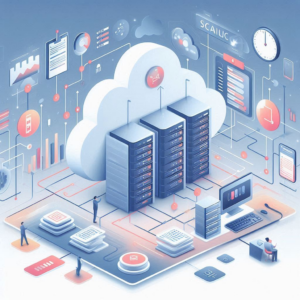Resource Allocation Strategies for Cloud Management

1. Introduction to Resource Allocation in Cloud Management
Resource allocation is a key part of cloud data management. It ensures that computing power, memory, and storage are used efficiently. Proper strategies help businesses scale up, reduce costs, and maintain good performance. As demand changes, effective resource management allows companies to stay responsive and avoid slowdowns or wasted resources.
2. Understanding Resource Allocation in Cloud Environments
Cloud resource allocation means assigning computing resources to different tasks based on needs. A well-planned allocation prevents overuse (which raises costs) or underuse (which slows down performance).
There are two main types of resource scaling:
2.1 Vertical Scaling (Scaling Up)
This method increases the power of a single machine by adding more memory, processing speed, or storage. It improves performance but has limits, such as a maximum upgrade capacity and possible single points of failure.
2.2 Horizontal Scaling (Scaling Out)
This approach involves adding multiple machines or instances to distribute workloads efficiently. Horizontal scaling is widely used in cloud environments due to its flexibility and fault tolerance. It enables organizations to handle large workloads without overwhelming a single resource.
3. Key Resource Allocation Strategies for Cloud Management
3.1 Designing for Scalable Resource Allocation
From the initial development phase, organizations should implement cloud architectures that support dynamic resource allocation. Leveraging cloud-native technologies, such as Kubernetes and containerization, ensures efficient scaling based on workload demands.
3.2 Implementing Auto-Scaling Solutions
Auto-scaling automatically adjusts computing resources based on predefined thresholds. Cloud providers such as AWS, Azure, and Google Cloud offer auto-scaling capabilities that ensure applications receive adequate resources during peak demand while scaling down during low usage periods.
3.3 Data Partitioning and Sharding
As data volume grows, partitioning or sharding optimizes storage and retrieval efficiency. By distributing data across multiple nodes, organizations prevent single points of failure and enhance query performance.
3.4 Load Balancing for Efficient Resource Distribution
Load balancers distribute incoming traffic across multiple servers, preventing overload on a single instance. This strategy improves performance, minimizes downtime, and ensures high availability of applications.
3.5 Caching for Optimized Performance
Caching frequently accessed data reduces the load on databases and accelerates response times. Implementing caching mechanisms such as Redis or Memcached can significantly improve resource efficiency.
3.6 Proactive Monitoring and Analytics
Monitoring cloud environments is crucial for identifying resource allocation inefficiencies. Tools such as Prometheus and Grafana provide real-time insights into CPU utilization, memory usage, and network bandwidth.
3.7 Cost Optimization in Resource Allocation
While ensuring scalability, businesses must optimize costs by analyzing usage patterns. Implementing reserved instances, spot instances, or serverless computing can reduce unnecessary expenses.
4. Challenges
4.1 Complexity of Resource Management
As cloud environments scale, resource allocation becomes increasingly complex. Organizations need automated tools to manage distributed infrastructure effectively.
4.2 Data Consistency in Distributed Systems
Ensuring data consistency across multiple instances is a challenge. Strategies like eventual consistency and distributed databases help mitigate these risks.
4.3 Avoiding Vendor Lock-In
Over-reliance on a single cloud provider may limit flexibility. Multi-cloud strategies offer greater control and reduce dependency on a single vendor.
4.4 Addressing Performance Bottlenecks
Performance degradation can occur due to inefficient resource allocation. Continuous monitoring and optimization are essential for maintaining system performance.
4.5 Security Considerations in Resource Allocation
Scaling cloud environments can introduce security vulnerabilities. Organizations must implement encryption, access controls, and compliance frameworks to ensure data protection.
5. Best Practices
5.1 Leveraging Microservices Architecture
Microservices allow applications to scale specific components independently, improving resource efficiency and fault tolerance.
5.2 Utilizing Serverless Computing
Serverless computing enables applications to scale dynamically without managing underlying infrastructure. Services like AWS Lambda and Google Cloud Functions optimize resource allocation.
5.3 Using Managed Services
Cloud providers offer managed services for databases, storage, and machine learning workloads, reducing the operational burden on IT teams.
5.4 Implementing CI/CD Pipelines
Continuous Integration and Continuous Deployment (CI/CD) pipelines streamline application updates while ensuring optimal resource usage.
5.5 Regular Performance Audits and Optimization
Periodic evaluations of cloud resource allocation help identify inefficiencies and cost-saving opportunities. Organizations should proactively optimize workloads based on real-time usage data.
Conclusion
Effective resource allocation is key to managing cloud workloads efficiently. By using auto-scaling, load balancing, caching, and monitoring, companies can keep their cloud environments fast, reliable, and cost-effective.
Additionally, adopting a microservices approach, leveraging serverless computing, and using managed services can further enhance scalability. As cloud technologies continue to evolve, staying informed about the latest advancements in scaling infrastructure is essential for maintaining an efficient and resilient cloud environment. Organizations that prioritize effective resource allocation can unlock the full potential of cloud computing, driving innovation and delivering seamless user experiences.
Do you like to read more educational content? Read our blogs at Cloudastra Technologies or contact us for business enquiry at Cloudastra Contact Us.